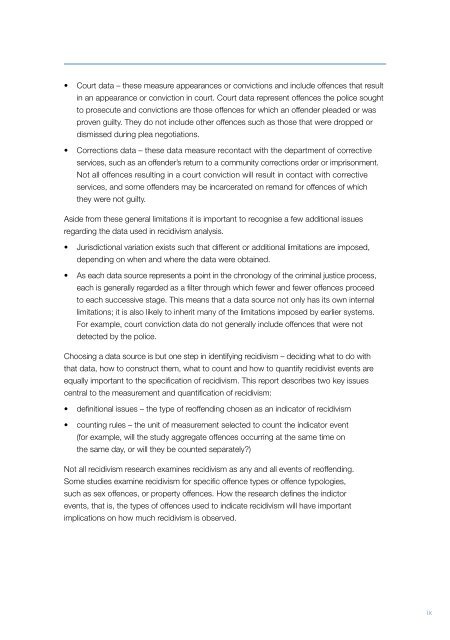Recidivism in Australia : findings and future research - Australian ...
Recidivism in Australia : findings and future research - Australian ...
Recidivism in Australia : findings and future research - Australian ...
You also want an ePaper? Increase the reach of your titles
YUMPU automatically turns print PDFs into web optimized ePapers that Google loves.
•<br />
•<br />
Court data – these measure appearances or convictions <strong>and</strong> <strong>in</strong>clude offences that result<br />
<strong>in</strong> an appearance or conviction <strong>in</strong> court. Court data represent offences the police sought<br />
to prosecute <strong>and</strong> convictions are those offences for which an offender pleaded or was<br />
proven guilty. They do not <strong>in</strong>clude other offences such as those that were dropped or<br />
dismissed dur<strong>in</strong>g plea negotiations.<br />
Corrections data – these data measure recontact with the department of corrective<br />
services, such as an offender’s return to a community corrections order or imprisonment.<br />
Not all offences result<strong>in</strong>g <strong>in</strong> a court conviction will result <strong>in</strong> contact with corrective<br />
services, <strong>and</strong> some offenders may be <strong>in</strong>carcerated on rem<strong>and</strong> for offences of which<br />
they were not guilty.<br />
Aside from these general limitations it is important to recognise a few additional issues<br />
regard<strong>in</strong>g the data used <strong>in</strong> recidivism analysis.<br />
•<br />
•<br />
Jurisdictional variation exists such that different or additional limitations are imposed,<br />
depend<strong>in</strong>g on when <strong>and</strong> where the data were obta<strong>in</strong>ed.<br />
As each data source represents a po<strong>in</strong>t <strong>in</strong> the chronology of the crim<strong>in</strong>al justice process,<br />
each is generally regarded as a filter through which fewer <strong>and</strong> fewer offences proceed<br />
to each successive stage. This means that a data source not only has its own <strong>in</strong>ternal<br />
limitations; it is also likely to <strong>in</strong>herit many of the limitations imposed by earlier systems.<br />
For example, court conviction data do not generally <strong>in</strong>clude offences that were not<br />
detected by the police.<br />
Choos<strong>in</strong>g a data source is but one step <strong>in</strong> identify<strong>in</strong>g recidivism – decid<strong>in</strong>g what to do with<br />
that data, how to construct them, what to count <strong>and</strong> how to quantify recidivist events are<br />
equally important to the specification of recidivism. This report describes two key issues<br />
central to the measurement <strong>and</strong> quantification of recidivism:<br />
•<br />
•<br />
def<strong>in</strong>itional issues – the type of reoffend<strong>in</strong>g chosen as an <strong>in</strong>dicator of recidivism<br />
count<strong>in</strong>g rules – the unit of measurement selected to count the <strong>in</strong>dicator event<br />
(for example, will the study aggregate offences occurr<strong>in</strong>g at the same time on<br />
the same day, or will they be counted separately?)<br />
Not all recidivism <strong>research</strong> exam<strong>in</strong>es recidivism as any <strong>and</strong> all events of reoffend<strong>in</strong>g.<br />
Some studies exam<strong>in</strong>e recidivism for specific offence types or offence typologies,<br />
such as sex offences, or property offences. How the <strong>research</strong> def<strong>in</strong>es the <strong>in</strong>dictor<br />
events, that is, the types of offences used to <strong>in</strong>dicate recidivism will have important<br />
implications on how much recidivism is observed.<br />
ix















